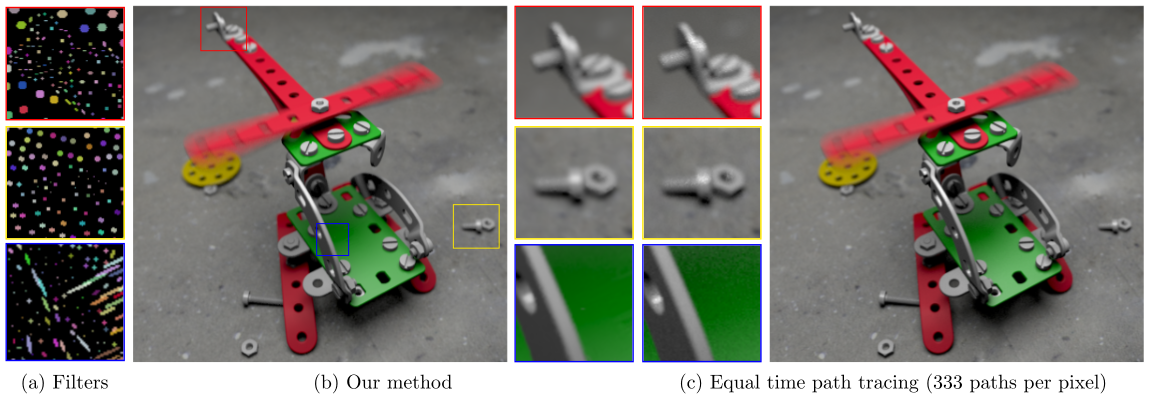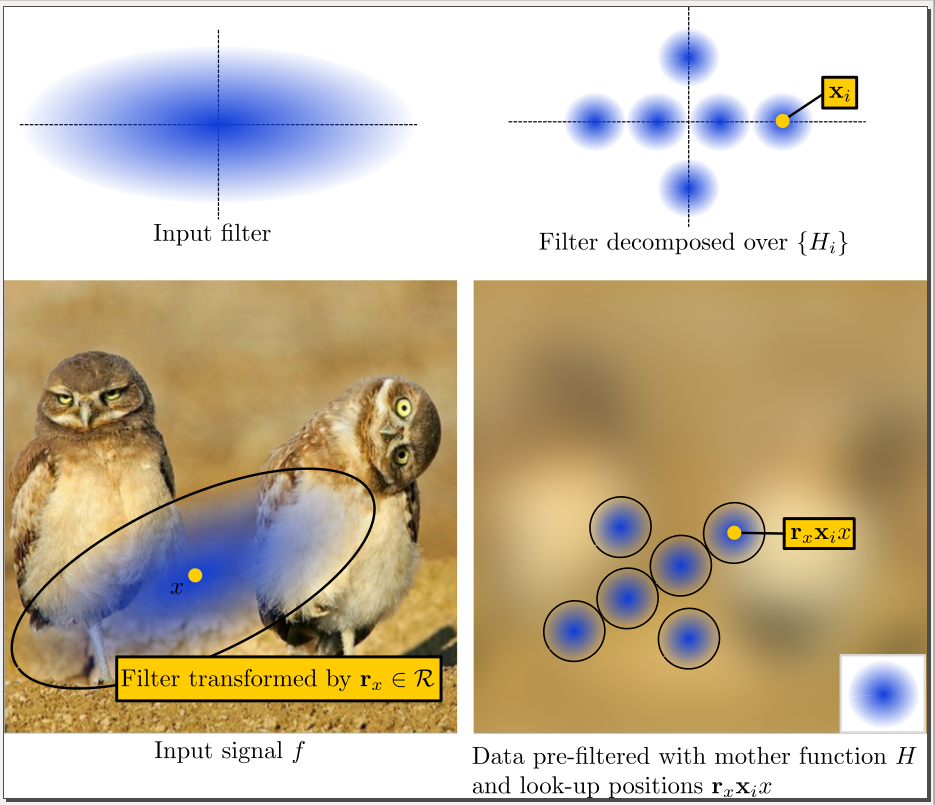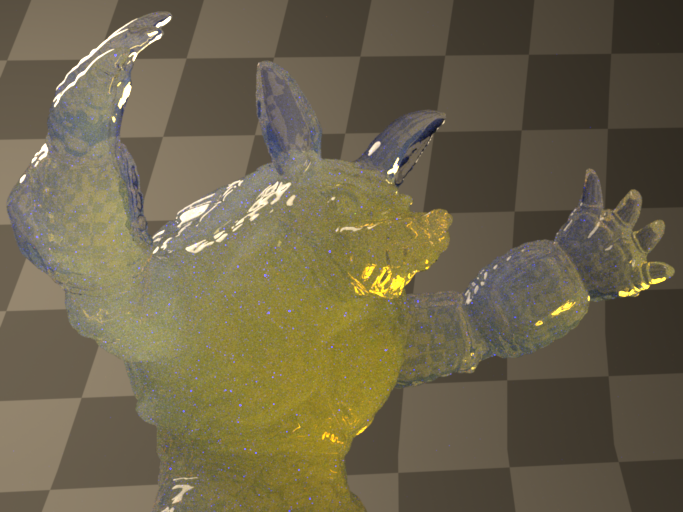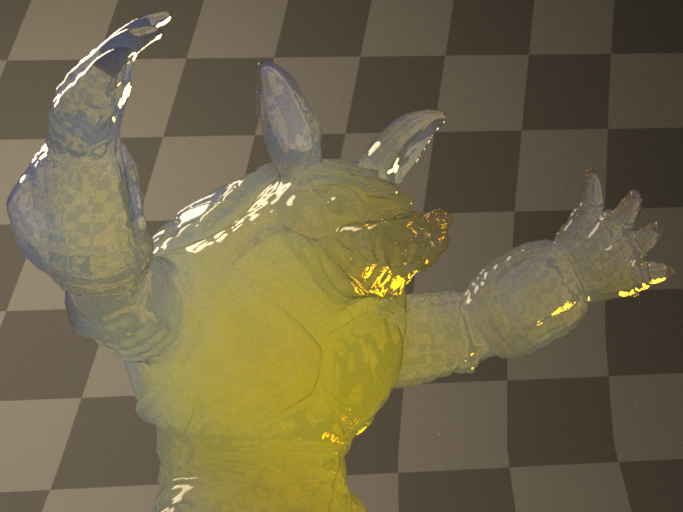Section: New Results
Realistic rendering
Interactive Rendering of Acquired Materials on Dynamic Geometry Using Frequency Analysis
Participants : Bagher M. Mahdi, Soler Cyril, Subr Kartic, Belcour Laurent, Holzschuch Nicolas.
Shading acquired materials with high-frequency illumination is computationally expensive. Estimating the shading integral requires multiple samples of the incident illumination. The number of samples required may vary across the image, and the image itself may have high- and low-frequency variations, depending on a combination of several factors. Adaptively distributing computational budget across the pixels for shading is a challenging problem. In this work, we depict complex materials such as acquired reflectances, interactively, without any precomputation based on geometry. In each frame, we first estimate the frequencies in the local light field arriving at each pixel, as well as the variance of the shading integrand. Our frequency analysis [1] accounts for combinations of a variety of factors: the reflectance of the object projecting to the pixel, the nature of the illumination, the local geometry and the camera position relative to the geometry and lighting. We then exploit this frequency information (bandwidth and variance) to adaptively sample for reconstruction and integration. For example, fewer pixels per unit area are shaded for pixels projecting onto diffuse objects, and fewer samples are used for integrating illumination incident on specular objects (See Figure 14 ). This work has been published in IEEE Transactions on Visualization and Computer Graphics [3] , as a follow up of a previous paper published at the I3D conference.
|
5D Covariance Tracing for Efficient Defocus and Motion Blur
Participants : Belcour Laurent, Soler Cyril, Subr Kartic, Holzschuch Nicolas, Durand Frédo.
The rendering of effects such as motion blur and depth-of-field requires costly 5D integrals. We dramatically accelerate their computation through adaptive sampling and reconstruction based on the prediction of the anisotropy and bandwidth of the integrand. For this, we develop a new frequency analysis of the 5D temporal light-field, and show that first-order motion can be handled through simple changes of coordinates in 5D. We further introduce a compact representation of the spectrum using the co- variance matrix and Gaussian approximations. We derive update equations for the 5 × 5 covariance matrices for each atomic light transport event, such as transport, occlusion, BRDF, texture, lens, and motion. The focus on atomic operations makes our work general, and removes the need for special-case formulas. We present a new rendering algorithm that computes 5D covariance matrices on the image plane by tracing paths through the scene, focusing on the single-bounce case. This allows us to reduce sampling rates when appropriate and perform reconstruction of images with complex depth-of-field and motion blur effects (See Figure 15 ). This work was published at ACM Transactions on Graphics [5] and presented at Siggraph'2013.
|
Accurate and Efficient Filtering using Anisotropic Filter Decomposition
Participants : Soler Cyril, Bagher Mahdi, Nowrouzezahrai Derek.
Efficient filtering remains an important challenge in computer graphics, particularly when filters are spatially-varying, have large extent, and/or exhibit complex anisotropic profiles. We explored an efficient filtering approach for these difficult cases based on anisotropic filter decomposition (IFD). By decomposing complex filters into linear combinations of simpler, displaced isotropic kernels, and precomputing a compact prefiltered dataset, we are able to interactively apply any number of—potentially transformed—filters to a signal (See Figure 16 ). Our performance scales linearly with the size of the decomposition, not the size nor the dimensionality of the filter, and our prefiltered data requires reasonnable storage, comparing favorably to the state-of-the-art. We apply IFD to interesting problems in image processing and realistic rendering. This work is currently under submission and a technical report is already available [21] .
|
Double- and Multiple-scattering Effects in Translucent Materials
Participants : Holzschuch Nicolas, Gascuel Jean-Dominique.
Some materials, such as coffee, milk or marble, have a soft translucent aspect because of sub-surface scattering: light enters them, is scattered several times inside before leaving in a different place. A full representation of sub-surface scattering effects in illumination simulation is computationally expensive. The main difficult comes from multiple scattering events: the high number of events increases the uncertainty on the result, forcing us to allocate more time for the computations. Recently, we showed that there is a strong correlation between the surface effects of multiple scattering inside the material and the effects after just two scatter events. This knowledge will help in accelerating multiple scattering effects (see figure 17 . We exploited this knowledge to provide a model and implementation for fast computation of double-scattering events, using a precomputed density function stored in a compact way. This work has been published in IEEE Computer Graphics and Applications [12] .







